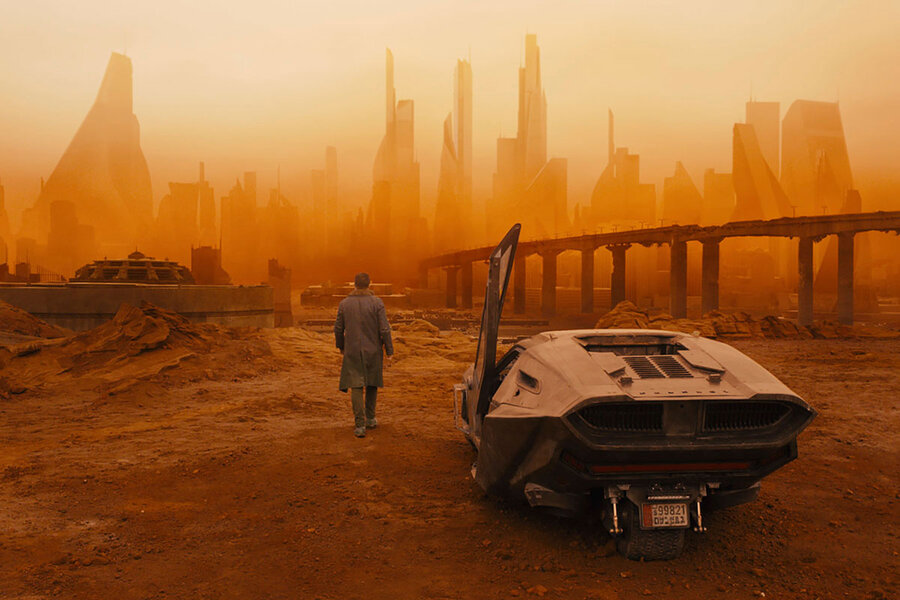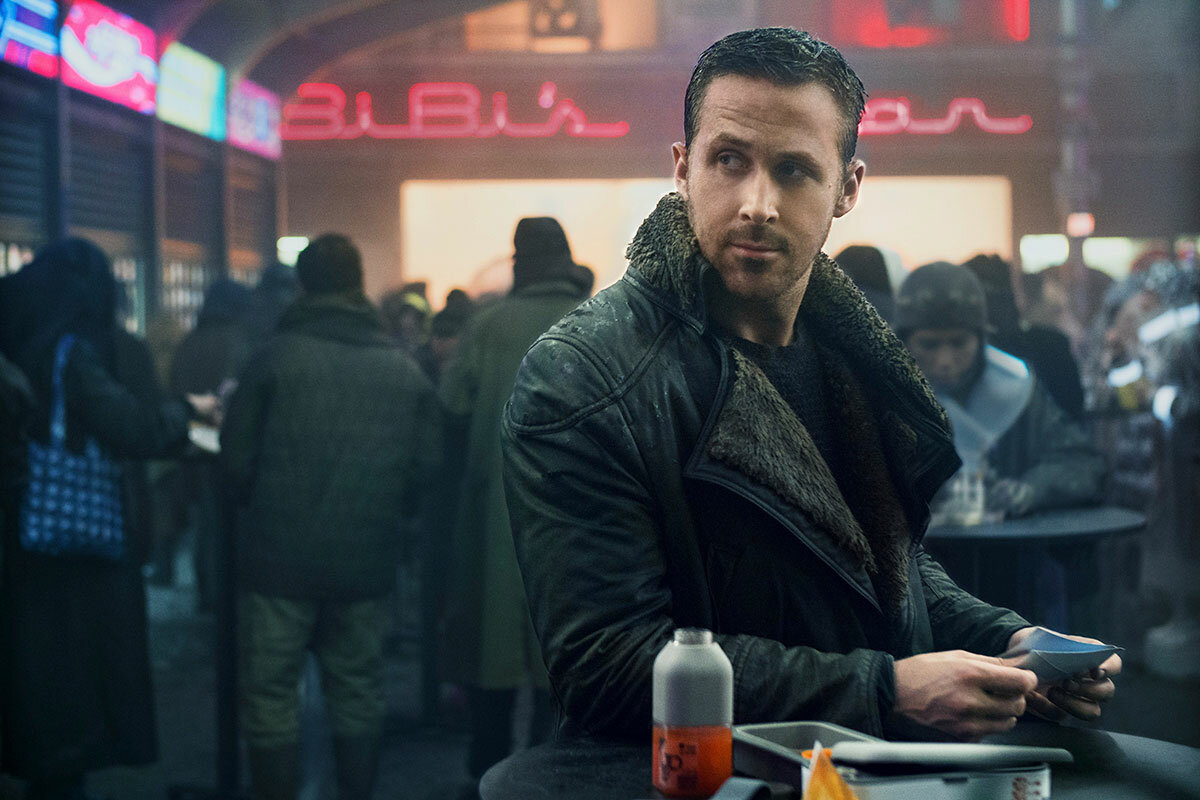'Blade Runner 2049': Why some science fiction writers are tired of dystopias
Loading...
In “Blade Runner 2049,” which opens Friday, post eco-disaster Los Angeles has built a massive coastline wall to fend off rising ocean levels. Few of the overpopulated city’s human or android occupants have ever seen a tree or a real animal. The incessant rain is as dour as Harrison Ford’s facial expressions. Worst of all? One character bemoans the fact that there’s no more cheese in the world.
Recent dystopian blockbusters seem to be jostling in a grim race to be the first to reach the seventh circle of hell in Dante’s “Inferno.” But some science-fiction writers are tired of the sorts of pessimistic futures depicted in movies and TV shows such as “The Hunger Games,” “Mad Max: Fury Road,” “Black Mirror,” and “The Handmaid’s Tale.”
In response, influential authors Neal Stephenson, Cory Doctorow, David Brin, and Kim Stanley Robinson argue that futuristic fiction should, instead, offer an inspiring outlook about mankind’s ability to shape its destiny. But do the kinds of stories we tell ourselves have a cultural impact on shaping a better tomorrow?
“I want to nod at something that Jill Lepore wrote in The New Yorker about the dangers of drowning ourselves in dystopian stories,” says Christopher Robichaud, who teaches a class at Harvard Extension School on Utopia and Dystopia in fiction and philosophy. “The utility dystopian fiction used to serve was to bring problems to our attention and seek solutions. But the danger is that these stories can become a collective act of despair in response to current events.”
The long-awaited sequel to the original “Blade Runner” certainly seems inspired by present-day concerns. It’s eerily in sync with Space X and Tesla founder Elon Musk’s claim that artificial intelligence will come to view humanity as an inferior species and destroy us. “Blade Runner 2049” also predicts bad outcomes from genetic editing, neurotechnology, surveillance technology, and energy use. The future’s only bright spot, it seems, is for umbrella manufacturers.
That sort of thinking made Mr. Stephenson wonder whether the pessimistic outlook of his profession had contributed to a defeatist attitude and lack of ambitious vision among scientists. So, in 2011, the author of classics such as “Snow Crash” cofounded the Hieroglyph project with the Center for Science and the Imagination at Arizona State University. The big idea: Develop science fiction stories with optimistic thought models and imaginative blueprints. The theory is that these narratives will, in turn, inspire scientists, engineers, and entrepreneurs to tackle major projects such as designing crewed spacecraft or finding viable alternatives to fossil fuels.
“When most people think of the future today, they think of the great dystopian narratives, especially through Hollywood and popular culture,” says Ed Finn, co-editor of the project’s 2014 anthology, “Hieroglyph: Stories and Visions for a Better Future.” “We started to ask how we can use storytelling to create more optimistic futures that are more empowering to people.”
'No such thing as defeating the technology'
But some science-fiction writers, including Ramez Naam (“Nexus”) and Daniel H. Wilson (“Robogenesis”), counter that dystopian tales can be just as valuable in shifting thought paradigms. Case in point: Mr. Wilson’s “Robopocalypse,” a story about a machine uprising so terrifying that readers may decide to leash their Roombas.
“I used that meme as a red cape to get the bulls to chase me,” says Mr. Wilson. “My goal was to subvert that theme. What I wanted people to take away from ‘Robopocalypse’ is that there is no such thing as defeating the technology. We are technology. We don’t survive without technology.”
And while novels such as Emily St. John Mandel’s “Station Eleven,” Maja Lunde’s “The History of Bees,” and Ernest Cline’s “Ready Player One” offer little respite from apocalypse, they’ve won both critical and popular acclaim.
Science fiction often plays on fears of technology’s unintended consequences. It’s a trope as old as Mary Shelley’s “Frankenstein.” Virginia Postrel, author of “The Future and Its Enemies: The Growing Conflict over Creativity, Enterprise, and Progress,” argues that optimistic science fiction stories don’t create a belief in technological progress. Rather, they reflect an existing, broader cultural outlook.
“If you think that the present is better than the past because of science and technology, then you are much more likely to find optimistic science fiction about the future to be plausible,” says Ms. Postrel. “If you think that science and technology have done nothing but destroy the planet and ruin our health, you will be drawn to pessimistic science fiction.”
Indeed, one puzzling aspect of dystopian science fiction is why stories about dismal futures are so popular during an era of unprecedented human progress. Global poverty is declining, infant mortality rates are falling, and life expectancy is rising.
“People refer to the Golden Age of sci-fi, which was a time of [Robert] Heinlein and ‘Star Trek’ and ‘The Jetsons,’ which reflected a fairly robust belief in the possibility of progress and that things will get better in the future,” says Ron Bailey, author of “The End of Doom: Environmental Renewal in the 21st Century.” But, he says, the new wave of science fiction after the mid-1960s reflected fears of nuclear annihilation, the loss of faith in institutions following the Vietnam War and “a relentless dystopian campaign by ideological environmentalists.”
'The importance of hope'
But perhaps the debate over utopian versus dystopian fiction should be reframed. A more helpful distinction might be the difference between nihilism and existentialism in science fiction. Amid doom-and-gloom scenarios, does the hero or heroine have agency and an ability to win the day?
“Dystopian fiction is pleasurable because we can enter from the side of the hero and track the hero’s journey and their statement,” says William Warner, a professor of English and Comparative Literature at the University of California, Santa Barbara.
Hieroglyph contributors and supporters Mr. Robinson (“New York 2140”) and Mr. Doctorow (“Walkaway”) have each written stories set in dystopian (and thus inherently dramatic) worlds that, paradoxically, often feel utopian. Crucially, their stories don’t leave readers feeling akin to Charlton Heston at the end of “Planet of the Apes.”
“New York 2140,” the latest book by Robinson, posits a future in which post-climate change Manhattan is partly submerged underwater. But his dystopian scenario is, in many ways, utopian. New York is flourishing as a "SuperVenice" in which, Robinson writes, “Not a few experienced an uptick in both material circumstances and quality of life.”
“Cory Doctorow likes to talk about the importance of hope – that you could hope for a better future,” says Mr. Finn. “That’s part of what differentiates our work from pure utopianism. We’re not so much focused on a perfect world. The work we do is trying to make our world better.”
Correction: The Hieroglyph project is run out of The Center for Science and the Imagination at Arizona State University.






